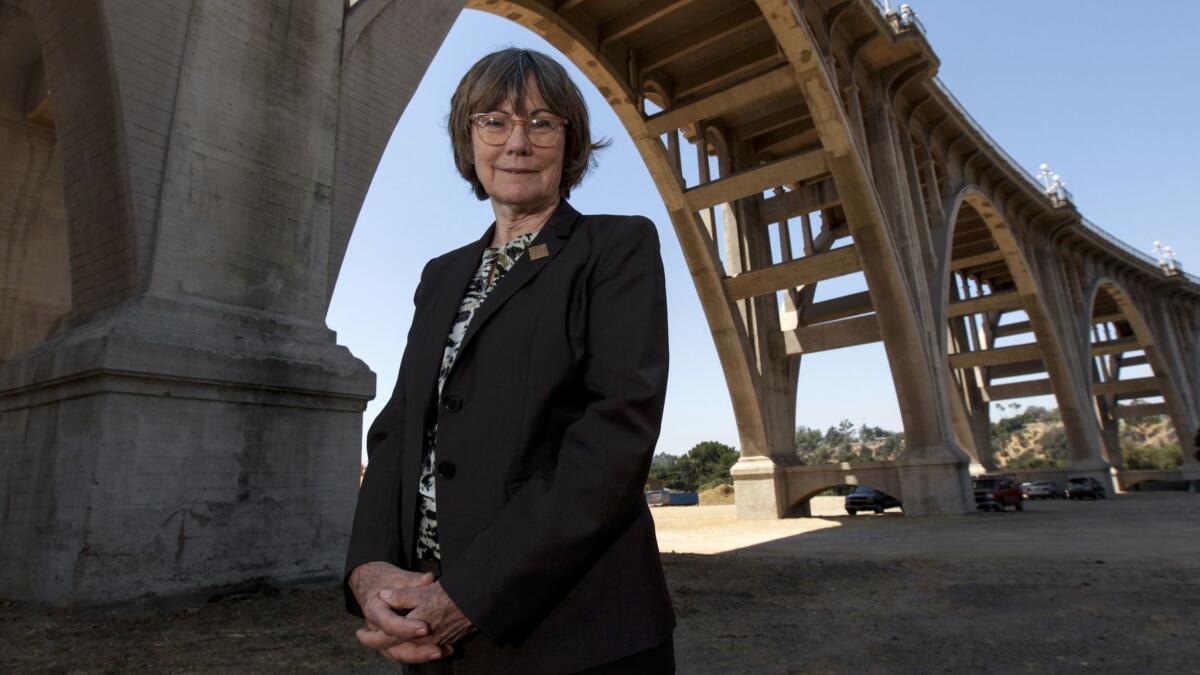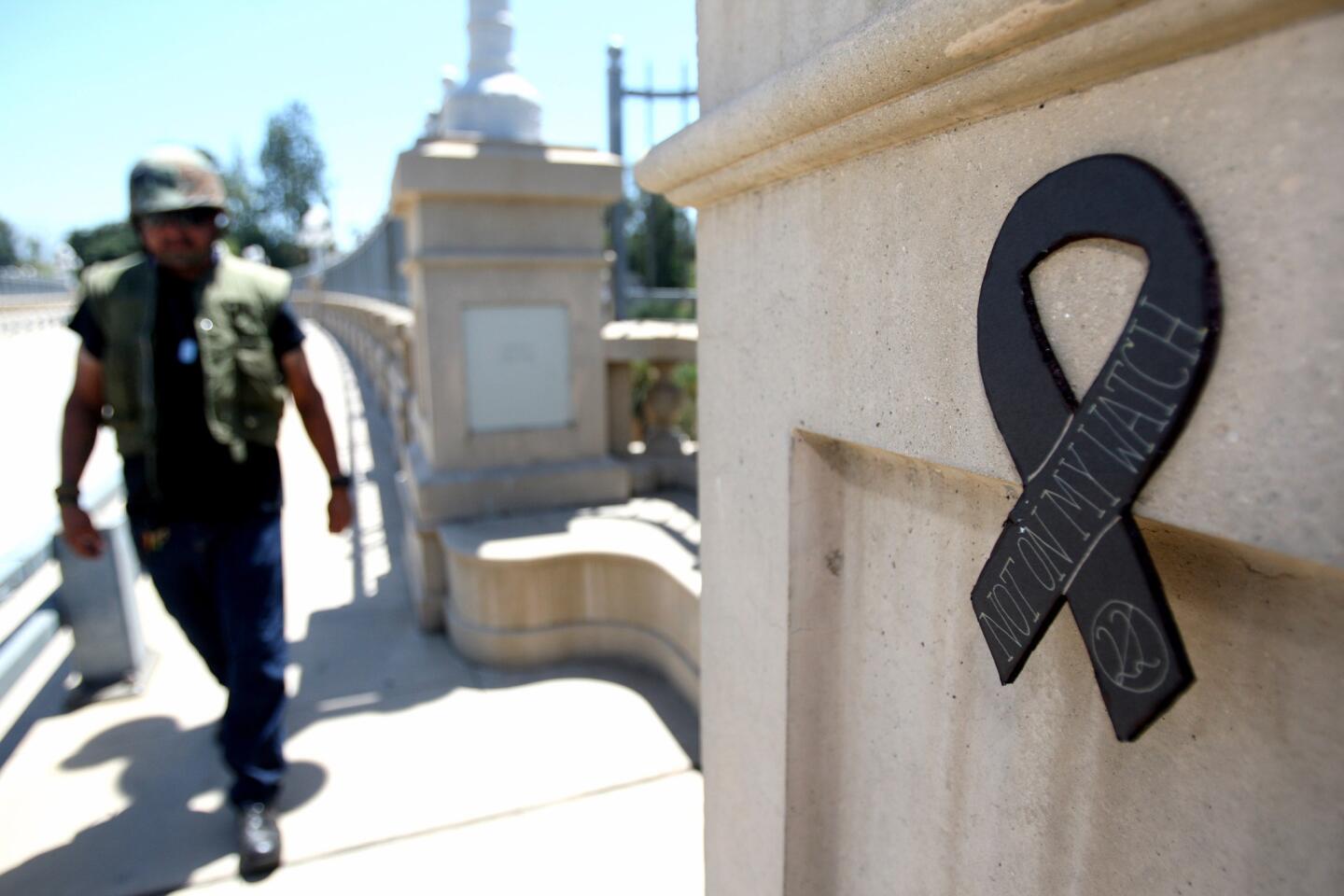Column: People keep leaping to their deaths from iconic Pasadena bridge. How do we stop them?

Pasadena is installing barriers on the Colorado Street Bridge to make it harder for someone to climb over the side.
- Share via
As you stand on the majestic Colorado Street bridge in Pasadena, high above the Arroyo Seco, it’s hard to imagine the depth of despair that would drive someone to jump.
“There is hope,” says a sign on the east side of the Beaux Arts bridge. The sign includes a crisis hotline number and an appeal.
“Suicide is not the answer. Make the call.”
A tally of despair
But there’s a long history of jumpers since the 1930s, with dozens of deaths during the Great Depression. And a recent surge has city officials scrambling to put up temporary barriers while deciding on permanent solutions.
The latest records show six deaths in four months.
March 3, female, 27.
April 15, male, 38.
June 2, female, 33.
June 23, female, 16.
June 28, male, 65.
July 2, male, 27.

They hailed from different neighborhoods and had different stories, but the endings were the same.
On Tuesday, work crews installed poles that will later have mesh stretched across them to block access to 20 pedestrian alcoves on the bridge, making it harder to jump the fence.
At 6 p.m. Wednesday, a City Council committee will review a staff report on possible long-term fixes, along with details on what other cities — including San Francisco — have done to thwart suicides from bridges. The proposals include full-time bridge patrols, higher fencing and netting draped under the bridge.
“We’re taking this very seriously,” Pasadena city spokesman William Boyer said. Police have gone to the bridge on 21 “mental health” calls this year, including the six suicides, three active attempts and a dozen more that could have become attempts if not for intervention.
The staff report plays devil’s advocate by asking:
“If we install barriers, won’t they just go somewhere else or choose another method?”
Not necessarily, given research on that subject. Considering the bridge’s history, it’s long past time to restrict jumping access and prevent copycat suicides, sparing families the enduring grief that accompanies such a loss.
It’s also worth noting that a small Habitat for Humanity housing project is nearing completion under the bridge, with more park space being added to what’s already a public recreation area along the arroyo. Because of the danger that poses on the ground, the city needs to get moving.
Steve Bridal, a contractor working on the housing development under the bridge, said he heard the sound of a jumper hitting the ground.
“It’s somebody you don’t know, but the act itself is a savage blow to the mind,” he said.
Suicide touches so many of us
Others said they have witnessed negotiations to talk jumpers off the ledge, and a worker named Jim suggested the city install cameras to alert police to possible jumpers.
Whatever city officials decide in Pasadena, the United States has about 44,000 suicides a year (half by firearms) and more than 1 million attempts, so a broader point has to be made about interceding before desperation takes someone to the edge of the abyss. So I took a companion to the bridge with me Tuesday morning.
Kita Curry is the head of Didi Hirsch Mental Health Services, which has a suicide prevention program that has served as a national model. I’d spoken to Curry in the past about mental illness and suicide in my own family.
My aunt threw herself into the river. My uncle shot himself in the head.
The only explanation I got, as a kid, was that they had the blues. The word “suicide” was not uttered, nor was there an explanation for this terrifying malady called the blues.
Curry has lost three family members to suicide, and for her, there’s an even more direct personal tie-in.
“I’ve been open about having attempted suicide myself,” said Curry, who described two times when untreated depression left her low and filled with dark thoughts. “It’s a strong genetic thing in my family.”
Battling hopelessness — and shame
Even as she talks about it, Curry notes her own hesitation, because of the history of stigma and shame associated with suicide. Didi Hirsch is about to open a stand-alone suicide prevention center, and the word “suicide” will appear on the building, she said, because it needs to be there.
A mental illness is present in about 90% of all suicides, said Curry, whose message to adults and teens is that help is available to anyone who feels depressed, alone, ashamed, lost, unloved, unworthy.
When minors ask her how someone can contemplate suicide, Curry has an answer:
“Because they had an illness that affected the way they think and feel, but there’s treatment for that.”

Maybe it’s my age, but it seems to me that getting through the day is often a complicated, disorienting enterprise. Adults struggle with the challenges of an economy that isn’t working for everyone, and younger folks live in a social media blur that can make them feel more alienated than connected.
Getting help is the key
The suicide rate has been rising for several years, with the highest rates among middle-aged men. For young people, suicide is the second-leading cause of death.
If you need help for yourself or a friend or loved one, you can learn about suicide risk factors and warning signs at didihirsch.org. The Los Angeles nonprofit also offers support groups for those who have attempted suicide and for those grieving the loss of a loved one. To find out about suicide prevention training, call (310) 895-2352.
In California, calls to the national Suicide Prevention Hotline — (800) 273-8255 — are often directed to Didi Hirsch counselors. Conversations are confidential, and callers are referred to therapists as needed.
We can all help, Curry said, by opening a door to those who withdraw, despair or exhibit risky behavior.
“There’s a whole group of very vulnerable people out there,” Curry said, “and we have to make sure they have access to help.”
Get more of Steve Lopez’s work and follow him on Twitter @LATstevelopez
MORE FROM STEVE LOPEZ
How one union boss manages to outfox L.A. politicians — and deliver the goods to his members
With millions set to lose Obamacare, DWP workers keep getting a sweeter deal
More to Read
Sign up for Essential California
The most important California stories and recommendations in your inbox every morning.
You may occasionally receive promotional content from the Los Angeles Times.
















